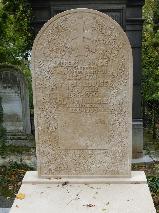Laprade, Albert |
| ARCHITECT (FRANCE) |
|
BORN 29 Nov 1883, Buzançais, Indre - DIED 9 May 1978, Paris GRAVE LOCATION Paris: Père Lachaise, Rue du Repos 16 (division 10, chemin Denon, ligne 01) |
|
Albert Laprade is best known for the Palais de la Porte Dorée, an exhibit hall in Paris next to the Bois de Vincennes that was constructed in 1931. He was the son of a wholesale grocer. After graduating from the Lycée Jean-Giraudoux in Châteauroux in 1900 he went to Paris where his uncle Ernest Cléret supported him. In 1905 he entered the studio of Gaston Redon and he also studied under Tournaire. After winning several prizes he obtained his architect diploma in 1907. He worked for René Sergent from 1910 to 1914. In 1914 he entered the army and in 1915 he was wounded at Ypres. He recovered in Rouen. The architect Henri Prost took him to Morocco as his assistent. There he worked in town planning. In 1920 he returned to France. In Paris he created the Jardins des Nympheas and the Jardins des Oiseaux in 1925. From 1925 to 1936 he cooperated with Léon Bazin (1900-1976). For the Paris Colonial Exhibition in 1931 he built the Palais de la Porte Dorée with Léon Jaussely (1875-1932). From 1932 to 1960 he was chief architect of Civilian Buildings and National Palaces and he was also General Inspector of Art Education. In 1936 he started his own company and from 1947 until his death he worked with Claude Barré (1920-1996). After the Second World War he focussed more on urban planning and restoration. He was the architect of the reconstruction of the old towns of Le Mans and Alençon. From 1955 to 1970 he supervised the banks of the Seine with Claude Charpentier. In 1963 he was elected into the Royal Academy of Belgium. He died in Paris in 1978. |



